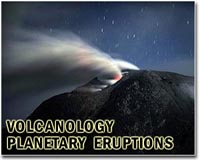| . |  |
. |
Washington (AFP) April 16, 2010 As ash from an Iceland volcano snarled air travel across Europe, experts said an eruption of the 'supervolcano' at the Yellowstone national park would be deadly, though it is unlikely any time soon. "The next major eruption for Yellowstone, if you have a guess, is probably thousands of years in the future," Bill Burton, a vulcanologist with the US Geological Survey, told AFP. The volcano, dubbed a 'supervolcano' because of its enormous strength, has not erupted for hundreds of thousands of years. It last erupted some 640,000 years ago, and the two prior eruptions were 1.3 million and 2.1 million years ago. That track record -- a major event approximately each 730,000 years -- suggests the volcano won't erupt again for another 90,000 years, though Burton noted that there is no real certainty when it comes to volcanic activity. "You cannot be totally complacent and assume nothing is going to happen," he said. For vulcanologists, the key is continued study of the history of individual sites. "The more we know about their past behavior makes you a little more confident about what's going to happen next," Burton said. Some volcanos erupt regularly, every ten years, usually providing signs of instability in the run up to an eruption. Others lie dormant for extremely long periods. Experts will examine a volcano's history of eruptions, but also use surveillance techniques and technology including GPS to detect whether the volcano is "swelling" because of pressure created by magma. "If the seismicity and the GPS start showing signs of magma moving then its time to think about gas coming out," Burton said. "So we keep track of all of those things and the more data... you have, the better." An eruption at Yellowstone, though unlikely in the near future, would have devastating consequences, Burton said. "The impact would be severe," and would likely send large quantities of volcanic material into the atmosphere. Yellowstone's last eruption, some 640,000 years ago, sent an estimated 1,000 cubic kilometers of ash and volcanic rock over the American west and parts of the Midwest, spreading as far south as Mexico. The eruption was some 3,000 times stronger than that at Mount Vesuvius in the year 79, and around 1,000 times stronger than the 1980 eruption of Mount Saint Helens in the US northwest. A similarly violent eruption at Yellowstone could decimate the population, producing "crop failure (and) water contaminations," Burton said. The biggest volcanic eruption in the last two centuries, the 1815 eruption of Mount Tambora on the Indonesian island of Sumbawa, sent 160 cubic kilometers of volcanic debris into the atmosphere and caused an overall drop in global temperatures for the year -- a "year without a summer," Burton said. The disaster also killed at least 71,000 people. The eruption of the Toba volcano in Sumatra some 73,000 years ago, an event 1,000 times more powerful than the 1980 Mount St Helens eruption, may even have wiped out most of the human race, according to a theory based on fossil evidence.
Share This Article With Planet Earth
Related Links Bringing Order To A World Of Disasters When the Earth Quakes A world of storm and tempest
 Iceland volcano could erupt for months
Iceland volcano could erupt for monthsMelbourne (UPI) Apr 16, 2010 The Icelandic volcano closing airports across Europe could erupt for months, a geologist says. The volcano under the Eyjafjallajokull glacier erupted continuously for about six months two centuries ago, University of Melbourne earth sciences Associate Professor David Phillips told The Age. That eruption, in 1823, caused a fatal glacial lake outburst flood. The 5,466-foot-h ... read more |
|
| The content herein, unless otherwise known to be public domain, are Copyright 1995-2010 - SpaceDaily. AFP and UPI Wire Stories are copyright Agence France-Presse and United Press International. ESA Portal Reports are copyright European Space Agency. All NASA sourced material is public domain. Additional copyrights may apply in whole or part to other bona fide parties. Advertising does not imply endorsement,agreement or approval of any opinions, statements or information provided by SpaceDaily on any Web page published or hosted by SpaceDaily. Privacy Statement |